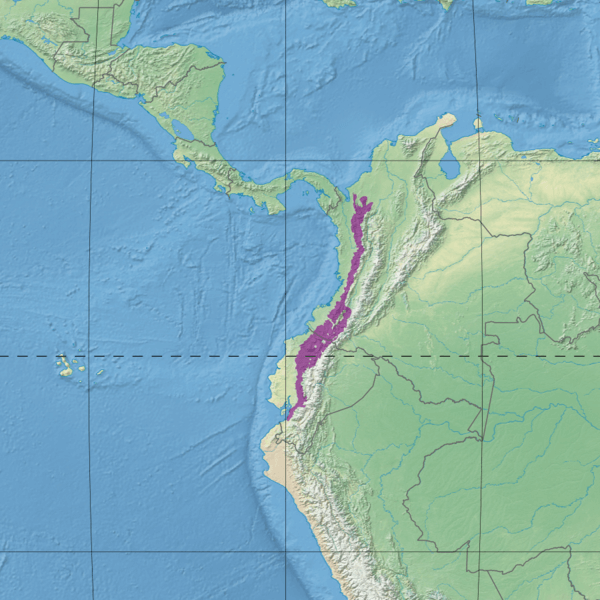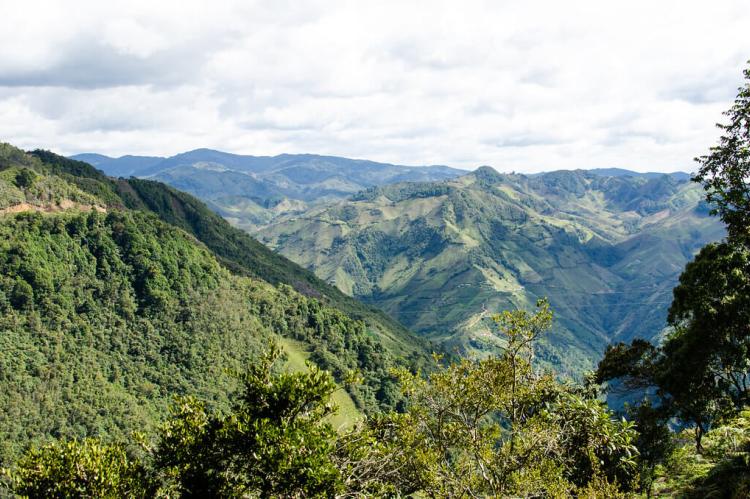Northwestern Andean Montane Forests: Exploring Colombia and Ecuador's Biodiversity Hotspot
The Northwestern Andean Montane Forests ecoregion, encircling the Andes Mountain's western slopes in Colombia and Ecuador, is a diverse and intricate ecological system. It comprises habitats that support a unique collection of flora and fauna, ranging from foggy cloud forests to sunny valleys below.
Northwestern Andean Montane Forests: Exploring Colombia and Ecuador's Biodiversity Hotspot
Enveloping the western slopes of the Andes Mountains in Colombia and Ecuador, the Northwestern Andean Montane Forests ecoregion is a stunning example of South America's natural beauty. This biodiverse hotspot comprises altitudes from 1,000 to 3,000 meters (3,280 to 9,840 feet) above sea level. It is made up of a variety of habitats, each fostering a unique assemblage of flora and fauna. The region's ecological tapestry is rich and complex, from the mist-shrouded cloud forests to the sun-drenched valleys below.
Geography and Climate
The Northwestern Andean Montane Forests ecoregion spans approximately 81,326 square kilometers (31,368 square miles) along the western slopes of the Andes Mountains in Colombia and Ecuador, influenced by the towering peaks and the nearby Pacific Ocean. This biodiverse hotspot boasts a wide range of elevations, from the mist-shrouded summits of the Andean cloud forests to the sun-drenched valleys below.
The ecoregion seamlessly merges into the Magdalena-Urabá moist forests ecoregion in its northern reaches. It transitions southward into the Chocó-Darién moist forests on the west and the Cauca Valley montane forests on the east. The higher elevations give way to Northern Andean páramo, while the central section almost surrounds the Patía Valley dry forests. Further south, the ecoregion transitions into the Western Ecuador moist forests to the west and the Eastern Cordillera Real montane forests to the east, ultimately merging into the Tumbes-Piura dry forests ecoregion at its southern end.
These transitions between ecoregions underscore the interconnectedness of ecosystems in the Andean region, contributing to the overall richness and complexity of the Northwestern Andean Montane Forests ecoregion.
At the highest altitudes, cloud forests cloak the landscape in perpetual mist and moisture. Moist air from the Pacific Ocean cools as it ascends the steep slopes of the Andes, condensing to create a microclimate characterized by high humidity and frequent precipitation. This misty environment fosters the growth of epiphytic plants such as orchids, bromeliads, and ferns, which cling to the branches of towering trees, forming a lush canopy overhead.
The climate of the Northwestern Andean Montane Forests varies with elevation, creating a patchwork of habitats that support a remarkable array of species. Cooler temperatures and higher humidity prevail at higher elevations, while lower valleys experience warmer and drier conditions, shaping the composition of plant and animal communities.
This ecoregion can be divided into at least three different life zones: pre-montane, montane, and upper-montane forests. Rainfall averages 2,000 - 4,000 millimeters (80 - 160 inches) annually but may drop to 1,000 - 2,000 millimeters (40 - 80 inches) at higher altitudes. The terrain, descending from the cloud forests, transitions into montane forests, characterized by dense canopies that provide habitat and sustenance for diverse wildlife. Beneath the canopy, a rich understory of shrubs, ferns, and mosses flourishes, contributing to the region's biodiversity.
Water plays a crucial role in shaping the landscape and supporting biodiversity throughout the ecoregion. Rivers and streams cascade down the mountainsides, carving deep ravines and providing essential habitats for aquatic species. Wetlands and marshes dot the valleys as critical breeding grounds for amphibians and waterfowl.
In summary, the Geography and Climate of the Northwestern Andean Montane Forests ecoregion create a diverse mosaic of habitats, each with unique environmental conditions and ecological communities, showcasing the resilience and interconnectedness of life in the Andes Mountains.
Flora of the Montane Forests
The Northwestern Andean Montane Forests ecoregion boasts unparalleled plant species richness, forming a botanical wonderland of extraordinary diversity and ecological significance. From towering emergent trees to delicate epiphytic ferns, the flora of this region encompasses a wide range of life forms, each playing a vital role in shaping the ecosystem.
At the heart of the montane forests, towering emergent trees dominate the canopy, their majestic forms reaching towards the sky. Among the most iconic of these is the wax palm (Ceroxylon spp.), the tallest palm species in the world, which towers above the forest canopy like a sentinel of the Andes. Another notable species is the quinine tree (Cinchona spp.), valued for its medicinal properties and distinctive bark.
The canopy of the montane forests provides habitat and sustenance for a multitude of wildlife, from arboreal mammals to canopy-dwelling birds. Epiphytic plants, including ferns, orchids, and bromeliads, adorn the branches of trees, forming lush gardens suspended in the air. These plants derive nutrients and moisture from the surrounding air and rainwater, creating microhabitats supporting diverse organisms.
Beneath the towering canopy, a luxuriant understory teems with life, with ferns, mosses, and lichens carpeting the forest floor. These low-growing plants play essential roles in nutrient cycling, soil stabilization, and microclimate regulation, contributing to the ecosystem's overall health and resilience.
Endemic plant species, adapted to the region's unique environmental conditions, are a hallmark of the Northwestern Andean Montane Forests. These species have evolved over millennia to thrive in the cool, humid montane climate, exhibiting a remarkable diversity of forms and adaptations. Endemic plants are integral to the ecoregion's ecological richness and resilience, from rare orchids hidden among the moss-covered branches to hardy ferns clinging to rocky outcrops.
In summary, the Flora of the Montane Forests in the Northwestern Andean Montane Forests ecoregion represents a botanical treasure trove of extraordinary diversity and ecological importance. From towering emergent trees to delicate epiphytic ferns, each plant species plays a vital role in shaping the ecosystem and supporting the region's rich biodiversity.
Fauna of the Montane Forests
The Northwestern Andean Montane Forests are a botanical wonderland and a haven for wildlife, harboring a diverse array of mammalian, avian, and amphibian species. Within the towering trees and dense undergrowth, a fascinating tapestry of life thrives, with each species playing a vital role in the ecosystem.
Mammals: Among the shadows of the montane forests, elusive mammals find refuge, their presence emblematic of the region's ecological importance. Species such as the spectacled bear (Tremarctos ornatus), South America's only bear species, and the Andean mountain tapir (Tapirus pinchaque), a unique and endangered herbivore, roam the forest floor in search of food and shelter. Other mammals, including the endangered mountain lion (Puma concolor) and the charismatic Andean cock-of-the-rock (Rupicola peruvianus), add to the richness of the region's mammalian diversity.
Birds: Avian diversity flourishes in the forest canopy, where a symphony of calls and colors fills the air. Endemic bird species such as the golden-plumed parakeet (Leptosittaca branickii) and the turquoise jay (Cyanolyca turcosa) add a splash of vibrancy to the verdant landscape. The Andean condor (Vultur gryphus), with its impressive wingspan, soars majestically overhead, while the resplendent quetzal (Pharomachrus mocinno), revered by ancient civilizations for its iridescent plumage, flits among the branches in search of fruit and insects.
Amphibians: Along the forest streams and pools, amphibians such as the iconic glass frogs (Centrolenidae) and tree frogs (Hylidae) find sanctuary. Their translucent bodies serve as indicators of environmental health, reflecting the pristine nature of their habitat. Despite their small size, these amphibians play crucial roles in nutrient cycling and insect control, contributing to the overall balance of the ecosystem.
Invertebrates: Beneath the forest floor, a hidden world teems with invertebrate life, from colorful butterflies to industrious ants. Pollinators such as hummingbirds and butterflies play essential roles in the reproduction of flowering plants, while decomposers like dung beetles and earthworms contribute to nutrient recycling and soil fertility.
Overall, the Fauna of the Montane Forests in the Northwestern Andean Montane Forests ecoregion represents a fascinating and vital ecosystem component, contributing to its ecological richness and resilience. By protecting and preserving these diverse species, we ensure the long-term viability of the montane forests and the myriad benefits they provide to both wildlife and human communities.
Conservation Challenges and Efforts
Despite their ecological significance, the Northwestern Andean Montane Forests confront numerous challenges threatening their long-term viability. These challenges range from habitat destruction and fragmentation to the insidious impacts of climate change, exacerbating pressures on vulnerable species and ecosystems.
Deforestation and Habitat Fragmentation
One of the most pressing threats to the Northwestern Andean Montane Forests is deforestation, driven primarily by agricultural expansion, logging, and infrastructure development. As human populations expand and demand for land and resources grows, pristine forest habitats are increasingly being cleared and fragmented, leading to biodiversity loss and ecological process disruption. The conversion of forests into agricultural land, particularly for cattle ranching and monoculture plantations, poses a significant threat to the region's rich biodiversity, displacing native species and altering ecosystem dynamics.
Illegal Logging and Poaching
Illegal logging and poaching further exacerbate the conservation challenges facing the Northwestern Andean Montane Forests. Despite legal protections, clandestine logging operations continue to plunder valuable timber resources, decimating ancient forests and disrupting fragile ecosystems. Wildlife poaching for the illegal wildlife trade also threatens the region's biodiversity, targeting species such as the spectacled bear and the Andean condor for their valuable pelts and body parts.
Climate Change
Climate change represents a looming threat to the Northwestern Andean Montane Forests, altering precipitation patterns, increasing temperatures, and exacerbating the frequency and intensity of extreme weather events. These changes have profound implications for the region's flora and fauna, disrupting ecological relationships and potentially driving species to extinction. Shifts in temperature and rainfall regimes may also lead to changes in species distributions and habitat suitability, further compounding the challenges faced by conservation efforts.
Conservation Efforts
Efforts to conserve the Northwestern Andean Montane Forests are underway, driven by collaboration between governmental agencies, non-profit organizations, and local communities. Protected areas such as national parks, biological reserves, and indigenous territories are bastions of biodiversity, safeguarding critical habitats and species from the threats of deforestation and habitat degradation. These protected areas are supported by a network of conservation organizations and research institutions, which tirelessly monitor biodiversity, implement sustainable land management practices, and develop innovative conservation strategies.
Community-based conservation initiatives are crucial in empowering local stakeholders as stewards of their natural heritage. Conservation organizations can foster partnerships that promote sustainable resource management, economic development, and cultural preservation by engaging with indigenous communities and traditional landowners. These collaborative efforts benefit biodiversity and contribute to the well-being and resilience of local communities, ensuring that the Northwestern Andean Montane Forests remain vibrant and biodiverse for generations to come.
Conclusion
The Northwestern Andean Montane Forests ecoregion, characterized by unparalleled biodiversity and ecological significance, is a testament to the intricate interplay between nature and humanity. From the misty heights of cloud forests to the verdant expanses of montane woodlands, this biodiverse hotspot encapsulates the essence of Colombia and Ecuador's natural heritage. Prioritizing conservation efforts and fostering sustainable development practices are imperative for ensuring the long-term viability of the Northwestern Andean Montane Forests for generations to come.

Map depicting the location of the Northwestern Andean montane forests (in purple).
